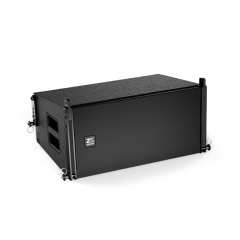Line array speakers, particularly powered line arrays are known to be perfect for concerts, big venues and outdoor shows as they have an excellent ability in delivering sound coverage especially when needed across wide areas. Some speakers combine multiple drivers in-a-single body, oriented vertically so sound can be more evenly projected over both short and long distances. This ensures that there is minimal drop-off in sound pressure levels (SPL) at increasing distance from the source. A line array speaker as above could maintain a level SPL over 100 meters, greatly superior to traditional point-source speakers in similar scenarios.
Another noteworthy factor that significantly influences the sound quality of powered line array speakers is their integrated amplification. The drivers are matched perfectly to their own amplifier in each speaker module. The outcome is an even better system all round, with less distortion lower down the volume scale and over a wider frequency range than would have been possible if subject to one-size-fits-all product engineering. These systems can deliver power outputs from 500W through to over a solid 2000 watts per module ensuring ample overhead when required to reproduce dynamic sound without clipping, providing minimum distortion energy.
Line array speakers with internal power also provide extensive digital signal processing (DSP) that lets you tailor your audio. Thanks to the flexibility of DSP, it also can be used for adjusting frequency response shape and phase alignment among different speakers, as well as applying time delays on each loudspeaker modules so everything will sound in synchrony. This sort of control is critical in environments with widely varying acoustics, such as stadiums or arenas where reflections and delays can degrade sound quality. One application is use of DSP in massive concert to make sure everyone hear a clear and understandable sound independently where each one standing.

The simplicity of setup and portability are also a couple among many other advantages powered line array speakers offer. Although they are deployed over large areas, these systems must be somewhat lightweight and modular with each individual module often weighing in at 40 to 80 pounds. Such modularity additionally offers flexibility in deployment, depending on the venue's size and needed scaling of the system. That could be as little work out doors for small outdoor event and need 2 to a few modules per side or an entire cluster of more than ten module in large concert that any banf I conects through one system.
A primary way this is seen in the field of sound reinforcement shows how systems like powered line array speakers have proven themselves as viable solutions at large-scale music festivals such as Coachella. These systems and their capability to project clear, high-energy sound out into crowds of tens-of-thousands across wide open|expansive outdoor grounds reveal the statement in general for live sounds reinforcement applications. This, coupled with their high output and extreme control of all the manipulation that they may perform standardize these in many large-scale audio production.
Powered line array speakers, meanwhile, represent a harvesting of investment in cost alone; typical prices range from $10K to upwards of 100 grand (before racks full other electronics), based on the number and technology-levels levels included. ROI, on the other hand can be huge particularly for professional audio companies or venues needing high- quality sound systems that are robust enough to handle many different kinds of events.
In sum—yes, my answer is conditional after all —powered line array speakers are unique due to their uniform sound dispersion and i tegrated amplification including advanced DSP capabilities;, along with light weighted structures for easy portability over distance, + their proven track record of performing in huge venues. These qualities are why they are an excellent pick for any scenario where high-level sound reinforcement is a must.